Trip Report - Japan Agricultural Situation
From June 3 - 10, 2012, USDA/FAS personnel and staff from the US Embassy in Tokyo visited two major agricultural areas of Japan - Niigata prefecture and city in the western part of the country, and Miyagi prefecture and the city of Sendai on the east coast. The purpose of the trip was to get an overall understanding of Japan’s agricultural sector, with an emphasis on rice production practices, consumption issues, and the recovery efforts following the March 11, 2011 earthquake and tsunami.
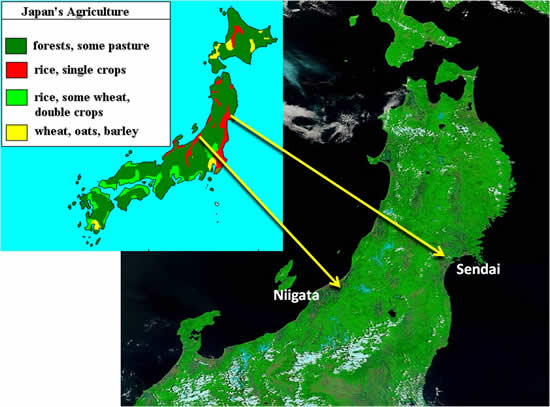
MODIS satellite image - May 27, 2012
The Importance of Rice
Rice is by far the most important crop in Japan and planted on the best agricultural land. Other crops grown in Japan include soybeans, wheat, barley, and a large variety of fruit and vegetables. The climate in Japan ranges from temperate in the north to semi-tropical in the south, with abundant rainfall (typhoons are common), hot summers, and relatively mild winters (except in the northern Japanese island of Hokkaido).
Japan’s Ministry of Agriculture, Forestry and Fishery (MAFF) has a Crop Production branch that collects agricultural data at the prefecture level, monitors crop development using weather data and satellite imagery, and publishes crop estimates. Rice forecasts are made in August and October, with final estimates coming out in December. Production data for minor crops (wheat, soybeans) are collected after the harvest and published in December.
USDA estimates the 2012/13 rice area at 1.55 million hectares, down 26,000 hectares from last year and down about 120,000 hectares from 5 years ago (2007/08). The current rice crop was transplanted in early May (about 1 month before the time of the trip) and was in the early vegetative/tillering stage. The weather at planting was generally favorable and Japanese officials said the crop was growing normally.
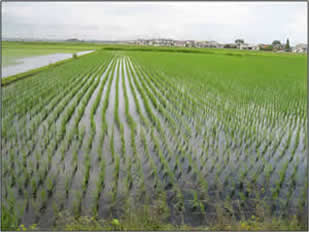 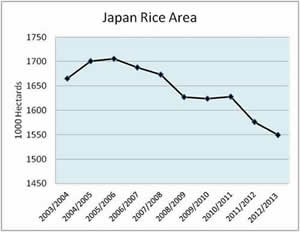
Source: Official USDA data, August 2012
Farmland is Precious
Farmland is scarce in Japan (only 12 percent of total area), and heroic efforts have been taken to expand and improve crop acreage in general and paddy land in particular. An example of this is the Kamedegou land improvement district (Niigata prefecture) which was established in 1951 to bring valuable but swampy cropland into production. There are major efforts underway near Sendai to repair the land and farming infrastructure damaged by the tsunami/radiation leaks following the “Great East Japan Earthquake” on March 11, 2011.
According to MAFF, approximately 23,600 hectares of arable land were damaged by the tsunami, including slightly more than 20,000 hectares of rice paddy. In the Sendai area, a majority of the damaged cropland is expected to be back in production within 3 years. However, there is no timetable for recovery of the farmland near the Fukushima nuclear power plant that was contaminated by radiation. The government has set precise testing requirements and radiation standards that must be met before farm production from the contaminated areas will be allowed on the market. Clean-up is proceeding very slowly and thousands of hectares of cropland is still off-limits to farmers. Government officials have stated that some land may need to be quarantined for 30 years or longer.
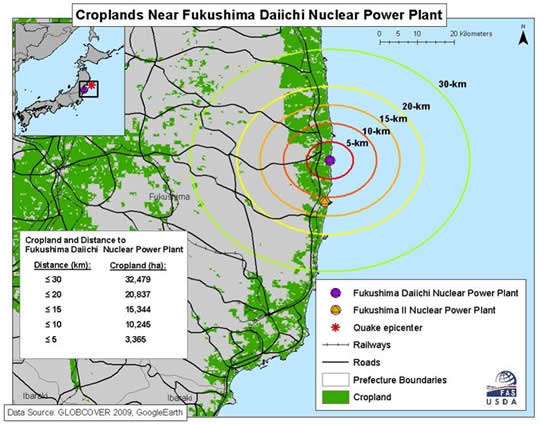
Farmers Adapt to Change
The problem of the rising age of farmers in Japan and the lack of interest in farming by young adults is widely acknowledged. Government statistics confirm the problem, but there are exceptions. We met several dynamic farmers who are finding flexible and creative solutions to the changing agricultural situation in Japan. A young farmer in Sendai (Mr. Kikuchi) transformed a damaged paddy field into a highly-productive hydroponic tomato greenhouse. Another farmer in Sendai (Mr. Endo) who lost his paddy land to the tsunami switched to soybeans and formed a company with his wife to produce miso. A third rice farmer (Mr. Konno) managed to clear his land, get back into production, and start rebuilding his destroyed house in less than a year with government assistance. In Niigata we talked with a farmer who owned a pear orchard, grew vegetables for a local farmers market, and hosted two young graduate students from the local agricultural college
Photos: Farm visits in Sendai and Niigata. P. Sandene, June 2012.
Japanese Food - Emphasis on Quality
Consumers in Japan are highly sensitive to quality issues in their food, demanding fresh, uncontaminated, and attractive products. In Japan, 7-Eleven and several other convenience store chains are very important outlets for moderately priced pre-cooked meals. These are prepared at central locations and delivered daily (sometimes more often), and the quality is very high. Niigata, Japan’s largest rice-growing prefecture, strongly promotes the locally-grown rice and is branding itself as a center of farming and fine cuisine. Last year, Niigata opened an innovative, high-tech education center designed to teach children (and adults) about farming, cooking, and nutrition, and the city sponsors food festivals each year.
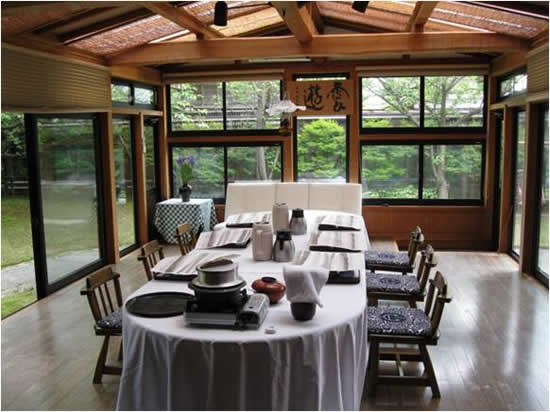
The per capita consumption of rice has been dropping for decades due to urbanization, adoption of western foods, and an aging population, but it remains the most important grain in their diet. The Japanese strongly prefer to eat the native Japonica (sticky) rice. Japan is required to import a set amount of rice each year (770,000 tons) under the terms of the WTO Minimum Access agreement, but most of this is put into storage or used for food aid or industrial processing (sake, rice flour, feed, etc). Efforts by the US rice industry to expand imports of US table rice into Japan have met with resistance from the government (through high tariffs – above 700 percent) and consumer preferences. A small amount of rice from California, China, Taiwan and other areas is imported each year.

Japan has a unique and complex food import and distribution network that is geared to moving produce as quickly and efficiently as possible, while maintaining the highest quality.
Since Japan is relatively small compared to the US, it is able to get food from farm to market very quickly. We visited the Ota Central Market, Japan’s largest wholesale market for fruit, flower, vegetable and marine products, where both imported and domestic produce is handled.
We also talked with Mr. Moriya, the president of Tokyo Seika Trading Co, the largest wholesaler at the Ota market, and Mr. Kazou, a manager at CO-OP, a vertically integrated food (and more) distribution company that operates nationwide.
After the Fukushima accident, the government of Japan created a new agency, the Consumer Safety Agency, to determine the safety of the food supply and answer questions and concerns from the public about radiation levels. Another agency with a similar responsibility for food safety is the Consumer Affairs Agency (which also handles product safety). The goal of the government is to ensure that the food supply is safe (via testing) and to re-establish consumer confidence.
U.S. - Japan Ties
In Sendai, we had an interesting and wide-ranging discussion with Seiji Mitsuishi, Professor at the Miyagi University in Japan, who is a leading expert on grains trade and teaches about world food systems. Mr Mitsuishi is the author of “Hog Lift and Corn from America – How grain trade built U.S.-Japan Ties”, which highlights the important role of international trade as part of food security. The book also discusses the future of agriculture and food in Japan.
Travel logistics and meetings were arranged by the USDA Office of Agricultural Affairs in Tokyo: Geoffrey Wiggins, Steve Shnitzler, Jennifer Clever, Yuichi Hayashi, Suguro Sato, and Kenzo Ito.
Current USDA area and production estimates for grains and other agricultural commodities are available on IPAD's Agricultural Production page or at PSD Online.
|

